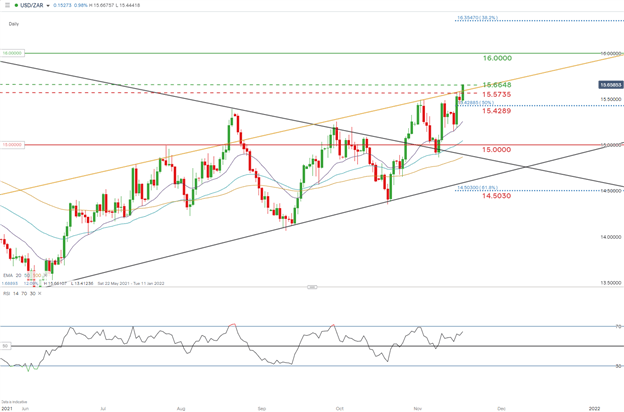USD/ZAR ANALYSIS
- MPC decides 25bps rate hike to 3.75%.
- USD/ZAR pushes to yearly highs on TRY collapse dismissing SARB announcement.
RAND FUNDAMENTAL BACKDROP
SARB DECIDES TO INCREASE RATES
The South African Monetary Policy Committee (MPC) was divided in their decision to raise rates with a 3-2 split favoring a rate increase. Prior to the announcement Governor Lesetja Kganayago outlined many factors that could easily result in a more dovish approach. A summary of these points are listed below:
- Incremental increases (25bps) are expected QoQ through 2022 – 2024 but is data dependent.
- Core inflation remains subdued.
- Loadshedding to hinder economic growth.
- 2021 Local growth revised lower.
- Some upside on faster risk vaccine rollout.
- South African linked commodity export prices estimated to fall.
- High oil price forecast emphasized.
- Escalating wage demands.
Source: DailyFX economic calendar
USD/ZAR PRE-ANNOUNCEMENT BUILD UP
Leading up to the SARB announcement, the rand has been depreciating against the U.S. dollar as a more hawkish Federal Reserve (Fed) favors further upside. Today, the Dollar Index (DXY) has been trading lower yet USD/ZAR is roughly 0.4% higher despite the fact that markets expect an interest rate hike.
The dynamics behind the rate announcement are complex as the SARB has to contend with several opposing factors.
- Inflation – In spite of rampant inflation pressures globally, South Africa’s figures remain comparatively low while remaining within the inflation target band of 3% – 6%. Although this is on the higher end, this does not lead me to believe a rate hike is targeted at combating inflation. From an historical perspective, inflation is relatively low as seen in the graphic below:
South African Inflation Rate (yellow) vs Unemployment Rate (blue):

Source: Refinitiv
- Unemployment – A recent announcement by Bloomberg in August 2021 revealed South African unemployment sits at the top of their list (total of 82 countries). Raising rates too quickly will further exacerbate an already poor situation and should be carefully considered by policy makers as to its long-term effects.
- Currency Depreciation – With central banks around the world growing increasingly more hawkish, an already vulnerable rand is susceptible to further weakness should no rate hike action take place. This is particularly true for G10 nations who are more inclined to bring forward their tightening outlook and reduce the ZAR’s carry trade appeal.
- Economic Growth – The strain of COVID-19 on commodity rich countries like South Africa have created a façade with the recent upsurge in commodity prices that have acted as a buffer to other economic challenges. These headwinds Currently Eskom has been struggling to combat power supply headwinds leaving South African businesses in tatters as disruptions create gaps in the business processes. Although a small rate hike may seem insignificant, the knock-on effects are definitely felt in such an environment. Access to low interest funding may act as a hindrance to additional economic expansion.
TECHNICAL ANALYSIS
USD/ZAR DAILY CHART
Chart prepared by Warren Venketas, IG
Resistance levels:
Support levels:
Contact and follow Warren on Twitter: @WVenketas



Be the first to comment